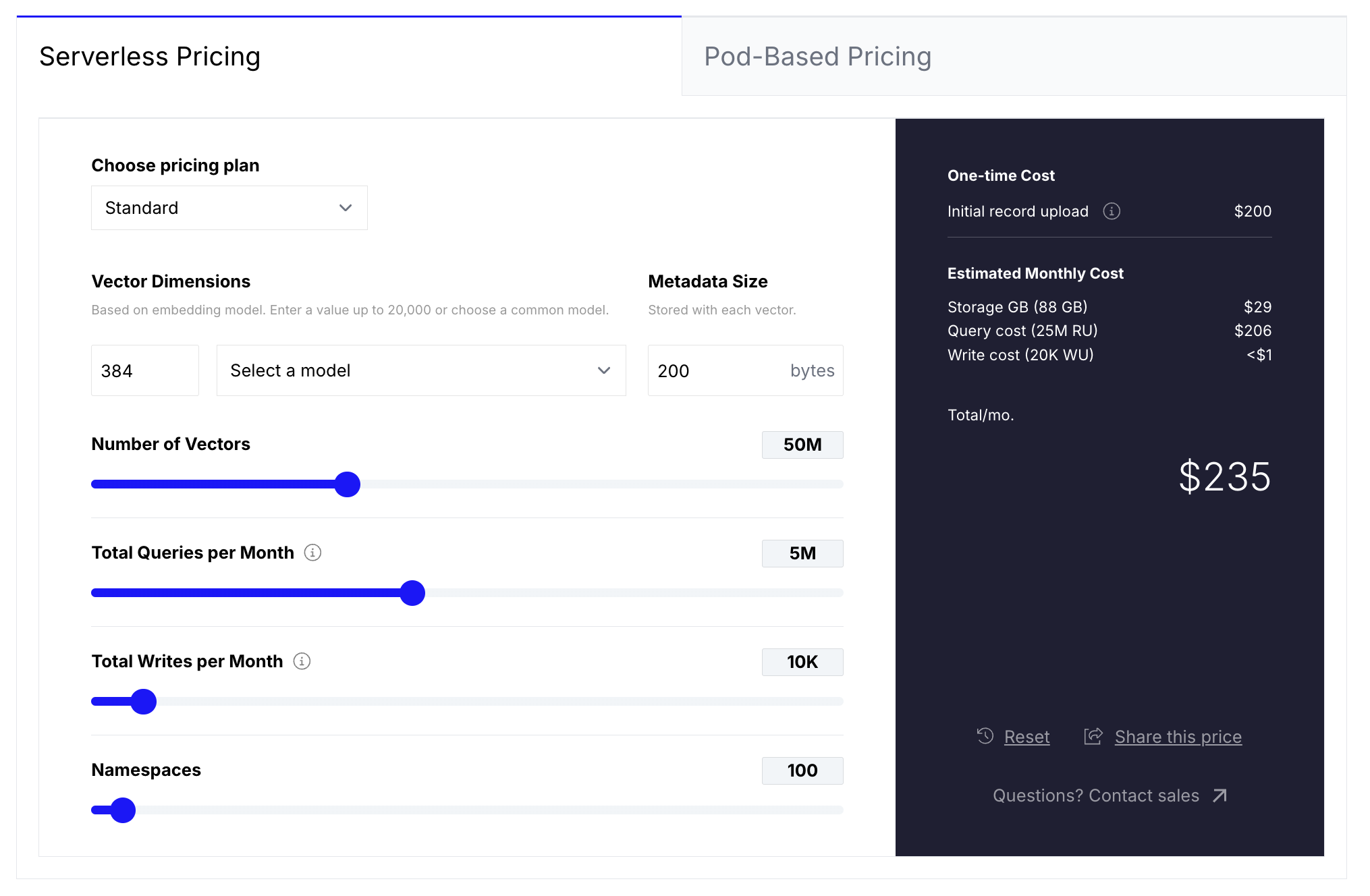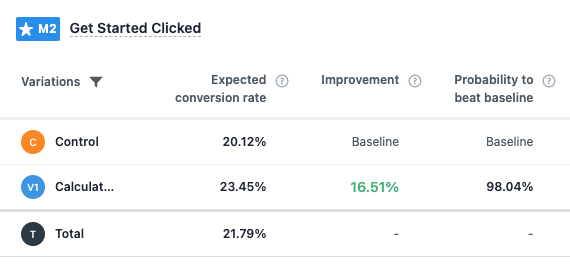2024-08-25 21:59:13
www.gkogan.co
You know the nagging feeling that your product, project, or company has become more complicated than it needs to be? You can solve many problems and get better results by doing something unthinkable to many: removing parts that once seemed essential. My crusade against complexity continues with this short story from Pinecone.
The calculator
The tricky thing about usage-based pricing is you can’t tell someone in advance exactly what the product will cost them. Like many companies in this situation, at Pinecone we decided long ago to put a calculator on the pricing page so would-be users can estimate their costs based on their intended usage pattern.

Everything seemed dandy, until … We talked to some would-be users and learned they were deterred from signing up because they were seeing extremely high estimates from the calculator. Yet their use cases seemed relatively small for Pinecone, so we dug into it and realized the calculator was far more confusing and sensitive than we thought. One slight misinterpretation and wrong input and you’d get an estimate that’s overstated by as much as 1,000x.
The calculator also gave users a false sense of confidence, which meant they were unlikely to double-check the estimate by reading the docs, contacting the team, or trying it for themselves. Instead, they took it at face value as the actual cost and made their decision right then and there.
We had to react quickly, faster than overhauling the pricing model would take. So came rapid-fire edits with descriptions, disclaimers, details, defaults, yadda yadda yadda. But any attempt to address one source of confusion inevitably added another.
Before long, a dedicated Slack channel was created, which accrued over 550+ messages representing opinions from every corner of the company. Another few thousand words and dozens of hours were spent in meetings discussing what we should add to the calculator to fix it.
Only one person dared to ask the question: “Do we, like, even need a calculator?”
Unfortunately, the suggestion got drowned out and dismissed by the crowd, and the conversations went spiraling on.
Over the next few days, as I slept on the issue, I thought how wonderful the world would be if that person was right…
🎶
Imagine there’s no calculator
It isn’t hard to do
Nothing to break or fight for
And no confusion, too
We’d save a lot of time on internal discussions and stop losing prospective customers who misunderstood the product’s cost. Meanwhile users, after getting the basic understanding that pricing is based on usage of X, Y, and Z, would be encouraged to test the product to see and extrapolate the actual costs for their specific usage pattern.
So we set up an A/B test to see if anything of value would be lost if the calculator — and all the hassles that came with it — was removed.

Within a few days, we had the answer: No, nothing of value would be lost. More than that, removing the calculator might’ve been better for users. Visitors who didn’t see the calculator were 16% more likely to sign up and 90% more likely to contact us than those who saw it. There was no increase in support tickets about pricing, which suggests users are overall less confused and happier.
If you’re surprised by this outcome, you’re not alone. In an internal poll, 7 of every 10 people in the company thought the version with the calculator would do better.
Dare to question and remove
Except for one person, it never occurred to this very smart group of people that removing the source of confusion could be a good option.
From my experience, this happens all too often: Companies, projects, products, software, strategies, everything gets cluttered with stuff that isn’t adding value. That stuff also inflicts pain, if not directly then by adding complexity. And once added, the stuff tends to stay for good because almost nobody thinks to or dares to remove it.
Here’s why:
- We tend to solve problems through addition rather than subtraction. Even when there’s tremendous upside to removing something, it’s not an obvious option. (Study: People systematically overlook subtractive changes)
- We’re usually rewarded for adding things rather than subtracting, and your company is probably no different. There’s rarely an incentive for removing stuff, though there should be.
- If we argued hard for something to be added, we may not want to admit it’s not adding value.
- If somebody else argued for the thing to be added, we don’t want to seem like we’re attacking their judgment or their work, so we leave it alone.
- We assume that if something exists then it exists for a good reason and doesn’t need revisiting.
- We get used to things the way they are. And their first response is an aversion to change, arguing against removal even before thinking through it.
Yet ruthlessly simplifying by cutting out non-essential elements can lead to great results. From better engagement with customers to more reliable systems to (as above) faster growth and more revenue. But it takes effort. You have to fight the tendency to make and keep things complicated. I don’t mean small cuts here and there but big chunks of your project, product, process, whatever. If there’s a big backlash from the team then you’re on the right path. The hard, counterintuitive, and unpopular removals are where the biggest gains are hiding.
Think of a complex problem you’re currently facing at your company, and ask yourself: Would anything of value be lost if this or that chunk of it was removed?
🎶
You may say I’m a dreamer
But I’m not the only one…
Support Techcratic
If you find value in our blend of original insights (Techcratic articles and Techs Got To Eat), up-to-date daily curated articles, and the extensive technical work required to keep everything running smoothly, consider supporting Techcratic with Bitcoin. Your support helps me, as a solo operator, continue delivering high-quality content while managing all the technical aspects, from server maintenance to future updates and improvements. I am committed to continually enhancing the site and staying at the forefront of trends to provide the best possible experience. Your generosity and commitment are deeply appreciated. Thank you!
Bitcoin Address:
bc1qlszw7elx2qahjwvaryh0tkgg8y68enw30gpvge
Please verify this address before sending any funds to ensure your donation is directed correctly.
Bitcoin QR Code
Your contribution is vital in supporting my efforts to deliver valuable content and manage the technical aspects of the site. To donate, simply scan the QR code below. Your generosity allows me to keep providing insightful articles and maintaining the server infrastructure that supports them.

Privacy and Security Disclaimer
- No Personal Information Collected: We do not collect any personal information or transaction details when you make a donation via Bitcoin. The Bitcoin address provided is used solely for receiving donations.
- Data Privacy: We do not store or process any personal data related to your Bitcoin transactions. All transactions are processed directly through the Bitcoin network, ensuring your privacy.
- Security Measures: We utilize industry-standard security practices to protect our Bitcoin address and ensure that your donations are received securely. However, we encourage you to exercise caution and verify the address before sending funds.
- Contact Us: If you have any concerns or questions about our donation process, please contact us via the Techcratic Contact form. We are here to assist you.
Disclaimer: As an Amazon Associate, Techcratic may earn from qualifying purchases.


















































![2024 Upgrade Tesla Model Y Sunshade Roof [Never Sag, No Gaps, Nano Ice-Crystal Coatings]…](https://techcratic.com/wp-content/uploads/2024/11/61USyoncEvL._AC_SL1500_-360x180.jpg)









![Japanese Movie – The X From Outer Space (Uchu Dai Kaijyu Girara) [Japan BD] SHBR-263](https://techcratic.com/wp-content/uploads/2024/11/81rV3BDVGJL._SL1024_-360x180.jpg)







